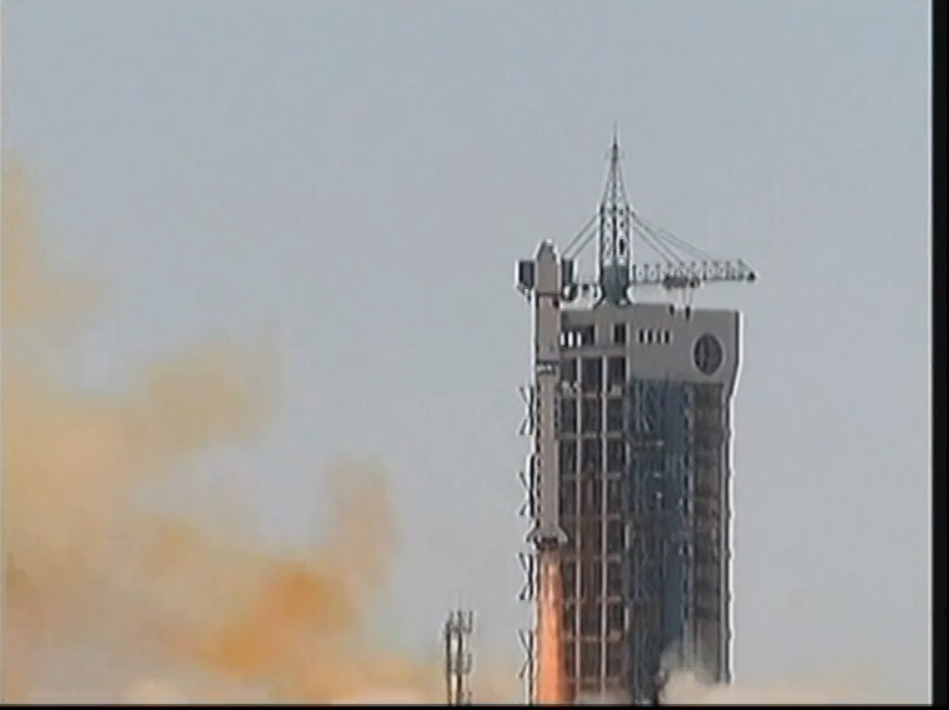Chinese Rocket Launches Four Satellites into Space

A Chinese Long March rocket blasted off from a remote desert launch base Friday (April 26) with a high-resolution Earth-imaging payload, Ecuador's first satellite and two other small satellites.
The Long March 2D rocket fired its hydrazine-fueled main engine at 0413 GMT (12:13 a.m. EDT) Friday and muscled off the launch pad at the Jiuquan space center in northwest China, powered by more than 650,000 pounds of thrust for the first 2 1/2 minutes of flight.
Liftoff occurred at 12:13 p.m. Beijing time. [2013 Rocket Launch Schedule]
The first stage engine gave way to the launcher's second stage to boost the mission's satellite passengers into orbit, where the payloads were released about 13 minutes after liftoff. The rocket was targeting a 422-mile-high (679 kilometers) sun-synchronous orbit optimized for imaging of Earth.
The flight's prime objective was deploying the Gaofen 1 Earth-observation satellite, a civil remote-sensing satellite launched to help Chinese officials respond to disasters, survey natural resources, plot urban growth and support national security applications, according to the state-run Xinhua news agency.
Gaofen 1 is the first of up to six similar remote-sensing satellites planned for launch through 2015.
Data from the Gaofen satellites will be used by civilian agencies within the Chinese government, including the Ministry of Land and Resources, the Ministry of Agriculture and the Ministry of Environmental Protection, Xinhua reported.
Get the Space.com Newsletter
Breaking space news, the latest updates on rocket launches, skywatching events and more!
Gaofen means "high resolution" in Chinese.
Moments after the Gaofen 1 satellite separated from the rocket, a cache of smaller passengers was supposed to be ejected into orbit.
The secondary payloads included three CubeSats: Ecuador's first satellite, a spacecraft built by students in Turkey and a technology demonstration platform from Argentina.
The Ecuadorian satellite — named NEE-01 Pegasus — is outfitted with a camera to stream live video from orbit in partnership with EarthCam, a company that broadcasts views from cameras worldwide on the Internet. The CubeSat will also transmit data and audio messages to the ground.
The cube-shaped satellite, measuring about 4 inches (10 centimeters) on each side, was developed by the Ecuadorian Civilian Space Agency, a non-profit, privately-funded organization set up in 2007.
Ecuadorian President Rafael Correa watched the launch from a control center in Guayaquil, the country's largest city, and congratulated the space agency on the launch.
Ronnie Nader, head of the space agency's space operations, tweeted: "Welcome to the sky, NEE-01 Pegasus. Welcome to space Ecuador."
The toaster-sized Turksat-3USAT spacecraft was built in a joint effort between Turksat, Turkey's communications satellite operator, and the Istanbul Technical University. The satellite carries a transponder to communicate with amateur radio hobbyists.
The CubeBug 1 satellite, sponsored by Argentina's Ministry of Science, Technology and Productive Innovation, will test custom-designed components in a small 5-pound (2.3 kilograms) spacecraft, according to its builders.
Copyright 2012 SpaceflightNow.com, all rights reserved.
Join our Space Forums to keep talking space on the latest missions, night sky and more! And if you have a news tip, correction or comment, let us know at: community@space.com.
Stephen Clark is the Editor of Spaceflight Now, a web-based publication dedicated to covering rocket launches, human spaceflight and exploration. He joined the Spaceflight Now team in 2009 and previously wrote as a senior reporter with the Daily Texan. You can follow Stephen's latest project at SpaceflightNow.com and on Twitter.

